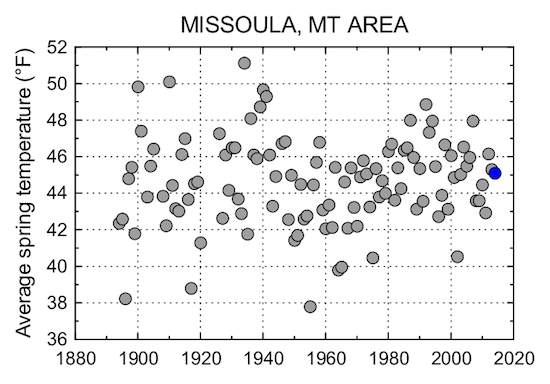By Sierra Rayne ——Bio and Archives--November 24, 2014
Global Warming-Energy-Environment | CFP Comments | Reader Friendly | Subscribe | Email Us
“Indeed, complications have already surfaced. Dennis Iverson runs a 140-head cow-and-calf operation on several thousand acres about 25 miles northeast of Missoula, Mont. Five hundred acres are hayfield, irrigated with water from the Blackfoot River about one and a half miles away. Twenty years ago, the water flowed through an open ditch, and from the time the irrigation pumps were started on May 20, 'we were able to irrigate the whole ranch,' he said. 'There was always enough water, even to do some irrigating in July and August.' Now, Mr. Iverson starts the pumps on May 10, because a hotter spring has already dried out his pasture. The open irrigation ditch has been converted into an 8,000-foot underground pipe to prevent evaporation. 'If we hadn't done that, we wouldn’t even be getting water to the ranch,' he said. 'There's that much less water in the stream than there was 20 years ago.'”A hotter spring has already dried out this pasture in the Missoula, Montana area? We can obtain climate data for the Missoula area from the NOAA National Weather Service database going back all the way to 1893. The average spring temperature in the Missoula during 2014 was 45 F. The average spring temperature in this area since records began 120 year ago? 45 F. Here is a plot of average spring temperatures in the Missoula region since records began (the blue dot is the 2014 data).
 There is absolutely no significant trend for average spring temperatures in this region since the 1800s, and over the past three decades there is very close to a significant declining trend in temperatures -- not increasing.
It is also possible to look at streamflow records in the Blackfoot River near Missoula. There has been no significant trend in annual streamflow since records began in 1940. Over the past three decades, the correlation has been positive -- and nearly statistically significant -- towards more streamflow, not less. Not a single individual month has a significant trend towards declining flows either since 1940, or during the last 30 years -- including the summer months. In fact, over the last three decades, flows during July and August have a positive correlation towards more water in the stream, not less.
It is long overdue for the media to stop reporting “traditional ecological knowledge” and its equivalents, and instead just stick to objective and verifiable scientific data.
There is absolutely no significant trend for average spring temperatures in this region since the 1800s, and over the past three decades there is very close to a significant declining trend in temperatures -- not increasing.
It is also possible to look at streamflow records in the Blackfoot River near Missoula. There has been no significant trend in annual streamflow since records began in 1940. Over the past three decades, the correlation has been positive -- and nearly statistically significant -- towards more streamflow, not less. Not a single individual month has a significant trend towards declining flows either since 1940, or during the last 30 years -- including the summer months. In fact, over the last three decades, flows during July and August have a positive correlation towards more water in the stream, not less.
It is long overdue for the media to stop reporting “traditional ecological knowledge” and its equivalents, and instead just stick to objective and verifiable scientific data.View Comments
Sierra Rayne holds a Ph.D. in Chemistry and writes regularly on environment, energy, and national security topics. He can be found on Twitter at @srayne_ca